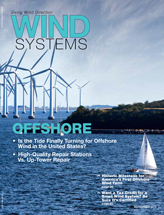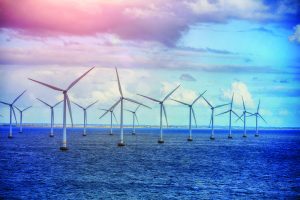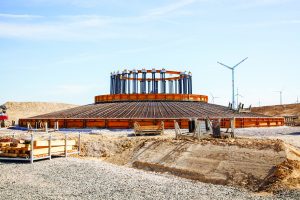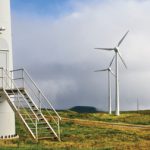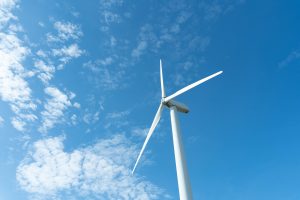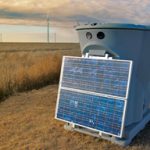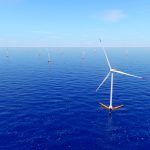For more than a decade, offshore wind has been viewed as the next big thing in the U.S. energy mix. In Europe, billions of euros have been invested in 82 offshore wind farms — 10.4 GW of capacity, according to the European Wind Energy Association (EWEA) — roughly equivalent to the power production of 10 large nuclear power plants. Meanwhile, the United States market stalled completely, mired in regulatory uncertainties, litigation, and lack of financing.
However, with the start of construction of the Block Island Wind Farm off the coast of Rhode Island this summer, the sector may finally be emerging. U.S. offshore wind resources are abundant, stronger, and blow more consistently than land-based wind resources, with an estimated 4,200 GW of developable offshore wind potential. Substantial development work already has been undertaken. As of late 2014, the U.S. Department of Energy (DOE) reported 14 offshore wind projects in advanced stages of development in the U.S. with over 4.9 GW of capacity.
U.S. offshore wind resources offer large economic benefits. According to the DOE, deploying 54 GW of U.S. offshore wind power could reduce the cost of electricity in the U.S. by $7.68 billion a year — equivalent to $100 per year for a family of four. As seen in Europe, offshore wind supply chain and construction activities will generate thousands of new jobs, infrastructure development, and related economic growth.

Offshore wind continues to face difficult regulatory and political hurdles in the U.S., including a maze of permitting and environmental laws and requirements. Opposition to offshore wind that is well-coordinated and amply financed by fossil fuel interests focuses on so-called “visual pollution” and harm to birds in seeking to block offshore projects at every level.
These obstacles have been evident in the struggles of the 130-turbine Cape Wind project in the Nantucket Sound off the coast of Massachusetts, which remains in limbo after more than a decade of planning, regulatory proceedings, and litigation. Other proposed projects off the coasts of New Jersey and Delaware have stalled in the face of similar obstacles.
When compared to Europe, U.S. developers also face major financial challenges, including higher costs of building offshore wind farms; the expense of transmission equipment for connecting them to the onshore grid; lack of governmental incentives and policy support; insufficient coordination among state, local, and federal agencies; and the resulting absence of debt financing necessary to fund the large required capital investments.
However, there are several reasons to believe the sector has reached an inflection point in 2015. Macro energy supply, economic considerations, and climate-related concerns support development of U.S. offshore wind projects (now more than ever), particularly in the New England and mid-Atlantic regions. Traditional coal-burning power plants are rapidly being retired, and they’re not being replaced. Offshore wind is one of the few resources offering the necessary scale to fill the coming void. Wind energy is also becoming far less costly, given technology improvements, and is increasingly supported by federal and state policies addressing climate change.
Can the U.S. offshore wind market finally turn the corner? Recent developments suggest that it could.
U.S. Offshore Wind Breaks Ground
A great deal of attention has been focused on the first commercial-scale offshore wind project to commence construction — the 30-MW Block Island Wind Farm off the coast of Rhode Island. Deepwater Wind, the project developer, estimates the project will generate over 100,000 MWh of energy annually. The project is expected to begin producing energy in late 2016.
Also, in late July, the Bureau of Ocean Energy Management (BOEM) approved DONG Energy’s acquisition of a 25-year commercial wind lease area in federal waters 55 miles off the coast of Massachusetts from RES Americas. The project could accommodate more than 1 GW of installed capacity. DONG Energy’s entry into the U.S. market is significant. Majority-owned by the Danish government, DONG is a heavyweight in European waters with about one-third of the offshore installations there. Earlier this year, DONG received an equity investment from Goldman Sachs, reportedly giving Goldman an 18 percent stake in the company. Goldman has been a leader in innovative project finance and public-private partnerships in other sectors. There is little doubt that it will pursue a comprehensive U.S. strategy to support its investment in offshore wind.
Beyond these recent developments, several broader market and regulatory features are evolving to support U.S. offshore wind, including those listed here.
Improved Turbine Size, Performance, and Reliability
The massive investments in Europe have driven major technology improvements. Turbine size and power output have substantially increased. For example, earlier this year, Siemens announced a new prototype turbine that increased capacity from 6 to 7 MW, using new magnet-based generator technology that eliminates gearing, and reengineered converter and transformer technologies, improving output by more than 10 percent. The Siemens system is optimized for reactive power compensation, contributing grid stability functions that are vitally important in regions such as New England and the mid-Atlantic.
Also, the Danish wind giant Vestas has deployed an 8-MW turbine as part of a joint venture with Mitsubishi Heavy Industries. In May, Vestas announced that a prototype set a new benchmark for power production, generating 192,000 kWh in a 24-hour period — enough to power approximately 13,500 Danish households. As recently as 2014, industry consultants were projecting that average turbine sizes would remain around 5 MW for pending U.S. projects. If the larger and better-performing European turbines can be rapidly deployed, that alone can be a game changer for the U.S.
Permit Streamlining
The Cape Wind project was expected to lead the way in opening the U.S. offshore wind markets. However, the project is stalled for the moment, entirely due to economic issues, as the off-takers withdrew from their power purchase agreements. Prior to that point, the project did successfully resolve regulatory and legal uncertainties, including securing all federal and state permits. Cape Wind shows the benefits of centralized federal agency jurisdiction and streamlined permitting under the provisions of the Energy Policy Act of 2005 that established permitting authority in the BOEM.
The Block Island project has clearly benefited from lessons learned by Cape Wind. Just two years after lease approvals, Deepwater Wind already has “steel in the water” as a result of collaborative efforts of state regulators and BOEM. The federal agency timely awarded a right-of-way grant for an 8-nautical-mile-long, 200-foot wide corridor in federal waters on the outer continental shelf for transmission to connect the wind farm to the mainland.
Improving Regulatory and Political Climate
The Obama Administration continues to support offshore wind. The DOE has promulgated a national plan calling for deployment of 10 GW of offshore wind capacity by 2020 and 54 GW by 2030. DOE’s Offshore Wind Innovation and Demonstration Initiative has several pilot projects designed to demonstrate offshore wind power technology advancements. BOEM also has implemented a streamlined integrated siting and permitting program called “Smart from the Start,” which has been a major aspect of the acceleration in project review times.
U.S. federal climate policy is generating further support. On August 10, the U.S. Environmental Protection Agency (EPA) announced final regulations implementing the Clean Power Plan (CPP), mandating states to achieve a 32-percent reduction from 2005 carbon emission levels from existing power plants by 2030. Many of the New England and mid-Atlantic states are viewing offshore wind as a key compliance measure. CPP requirements also can be met through state and regional trading programs, which are expected to generate new forms of bankable credits, thus providing further financial support for investments in offshore wind.
The broader political dynamic for offshore wind remains uncertain. There is some chance federal tax incentives will continue with the Production Tax Credit (PTC) extender bill passing the Senate Finance Committee on July 21. On August 12, Senators Tom Carper (D-Del.) and Susan Collins (R-Maine) reintroduced the Incentivizing Offshore Wind Power Act creating a tax credit for the first 3,000-MW offshore wind facilities placed into service. While the bill has little chance of being passed on its own, there is some potential that it could be rolled into comprehensive energy or tax reform legislation in the full Senate this fall. However, prospects for PTC extension or enactment of an Offshore Wind Investment Tax Credit this year will be tempered by the strong ideological opposition by Republicans controlling both the House and the Senate.
State level programs and incentives may be even more critical in providing revenue certainty to make projects viable and attractive to the equity and debt investors. States such as Massachusetts, New York, Rhode Island, Maine, Maryland, New Jersey, and Virginia are continuing to consider policies providing revenue certainty and financial support. Such incentives may include Offshore Renewable Energy Certificate (OREC) programs, centralized procurement processes and supply chain initiatives, targeted infrastructure development legislation, and programs providing financial support for private sector debt finance of new offshore projects.
For example, the Maryland Offshore Wind Energy Act of 2013 created an OREC system and mandated that if an offshore wind project is constructed, Maryland utilities will be required to procure up to 2.5 percent of their portfolio from offshore wind energy as early as 2017. A key political concern for these programs is ensuring ratepayer protection. The Maryland bill capped increased charges that could be passed along by the state’s utilities at an additional $1.50 per month on ratepayers’ electricity bills.
In March, the New York State Energy Research and Development Authority (NYSERDA) released a report concluding that with full support for offshore wind, the state can see price cuts of more than half by 2020, resulting from the use of larger turbines and cost reductions achieved by economies of scale. The Long Island-New York City Offshore Wind Collaborative is working on a utility-scale project to be located about 15 miles off the Rockaways on Nassau County’s southern shore.
In Massachusetts, proposed legislation would enable offshore wind projects to access investment-grade financing, as it would require local utilities to conduct four joint solicitations for offshore wind beginning October 1, 2016, and to enter into 20- to 30-year contracts with developers, provided the terms and prices of the responses are “commercially reasonable.” These ensured long-term contracts would increase security of payback for lenders.
States also may be able to do more to support project debt through public infrastructure finance. For example, New York’s Green Bank has received over $360 million in funding for renewable energy projects. As the Natural Resources Defense Council noted in a recent white paper, “It would be a powerful market precedent if the New York Collaborative — LIPA, NYPA, and Con Ed — were able to bundle New York Green Bank anchor financing together with lease and power purchase agreements and then competitively bid the entire package. This combination of revenue certainty, site control, and anchor financing would likely produce very competitive bids and low costs of delivered energy.” Major private sector participants such as Goldman Sachs will likely bring other innovative approaches to bear in supporting long-term wind project financing.
Additional Leases
The availability of lease sites — a crucial factor for successful project development — also appears to be trending upward. BOEM, in conjunction with several coastal state governments, is poised to reopen the procurement process for additional leases in New York and New Jersey, while stakeholders presently are being engaged in North Carolina and South Carolina. Acquiring projects in mid-development also is an option, although proposed lease assignments are subject to approval by BOEM.
Importance of a Developed Supply Chain
The success of offshore wind in Europe illustrates the importance of achieving critical mass in developing infrastructure and distribution to drive down costs. Here in the U.S., a number of states and organizations are working on this front. According to Liz Burdock, the executive director of the Business Network for Offshore Wind, “State offshore wind policies are really economic development policies. Denmark started with 10 offshore wind turbines; now more than 56,000 people are employed in the Danish wind industry. States must work together to build a pipeline of projects, which will incentivize the scale required to reduce costs and decrease risk so companies can make the necessary long-term investments required. Many U.S. companies are evaluating how they can pivot into the offshore wind supply chain. As the U.S. market emerges, the Business Network will help companies develop innovative technologies and processes and export to the €180 billion global offshore wind industry. It is important that we enhance U.S. business expertise and build out the supply chain now; otherwise, when commercial-scale U.S. projects go to construction, the work will be done by European firms.”
Progress in Offshore Wind Energy Transmission Capacity
Historically, U.S. offshore wind projects have been constrained by the lack of transmission capacity, requiring them to provide and finance their own infrastructure for transmission of wind energy to onshore uses. Progress is being made on the build out of the Atlantic Wind Connection, an undersea high-voltage transmission line that would provide a backbone to connect offshore projects extending from New York to Virginia. The first phase is scheduled to begin construction in 2016.
Maturing Onshore U.S. Wind Markets
Onshore wind energy has turned a corner in the U.S., reaching major milestones for market penetration, reduced costs, and job creation. The DOE recently reported that wind prices have hit an all-time low, with average levelized long-term prices at approximately 2.5 cents/kWh for projects contracted in 2014. Wind has comprised 33 percent of all new U.S. electric capacity additions since 2007, according to the DOE. With the maturation of the onshore sector, it can be expected that political support for nascent offshore projects will grow as well.
Availability of Financing
Obtaining financing for large offshore wind projects is a challenge. Banks and equity investors are wary of new technologies and the risks perceived to be associated with offshore wind energy. Yet the landscape appears to be shifting on the financing front as well. The Block Island project secured $290 million in debt and equity financing earlier this year. Given the relative speed with which the Block Island regulatory approvals were obtained, regulatory risks may become less of a concern for investors.
A 68-turbine project is being planned by US Wind, Inc., off the coast of Ocean City, Maryland, capable of generating 500 MW of electricity. To cover the project’s nearly $2.3 billion cost, the company plans to pursue a mix of financing mechanisms including substantial OREC financing to be repaid after the turbines are constructed and operating. Another project from the same developer as Block Island, Deepwater Wind, is Deepwater ONE, also in the Rhode Island Sound. This planned 150-200 turbine project will be capable of generating from 900 to 1,200 MW. Success in obtaining financing for these larger projects will be a key barometer indicating real progress.
Conclusion
Major deployment of offshore wind in the U.S. will require further progress in many of the areas discussed here. Given the economic, energy supply, and climate imperatives, however, there appears to be strong momentum building toward the long-awaited breakthrough in U.S. offshore wind capital investment and project development.
About Sullivan & Worcester, LLP
Sullivan & Worcester is a leading corporate law firm providing counsel to domestic and international clients ranging from Fortune 500 companies to emerging businesses. With more than 185 attorneys in Boston, New York, Washington, D.C., and London, the firm offers a full range of corporate legal services. It’s Energy Finance Practice Group represents clients in energy project development and finance transactions; acquisitions, sales and licensing projects; and energy and climate policy matters. The firm works as partners with its clients, providing legal support through the lens of its deep understanding of energy finance and the unprecedented change underway in the energy industry, to bring positive solutions and real value to its investments and businesses.
Members of the Energy Finance Practice have substantial experience in onshore and offshore wind energy matters. Representative matters include: represented the Conservation Law Foundation in support of the Cape Wind offshore wind project off the coast of Massachusetts, including in federal court litigation, administrative, and regulatory matters; served as North American counsel for a major vertically integrated renewable energy company, advising on offshore wind joint venture structuring, debt and equity investments, and regulatory matters; advised developers with respect to proposed offshore wind projects off the coast of New Jersey; represented an infrastructure development, management, and operations company building out a portfolio of wind power generation assets; performed due diligence supporting the purchase of a controlling interest in a 450-MW portfolio of three wind projects by the infrastructure fund of a major U.S. bank; and represented a leading European bank as lender to a nearly 400-MW wind generating facility in Texas.
For more information, go to http://www.sandw.com/practices-area-Energy.html or visit the firm’s blog, the Energy Finance Report, at http://www.energyfinancereport.com.
















